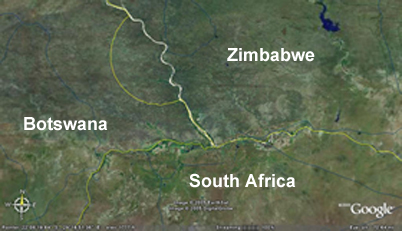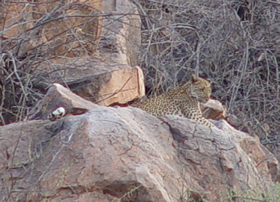| Large Predator Research Programme for the Shashe Limpopo Region | ||
|
|
The Shashe Limpopo Predator Research Group (S-LPRG) was formed as a result of the realisation that the populations of six predator species (lions, leopards, cheetahs, wild dogs, spotted hyaena and brown hyaena) occurred across the borders of the three countries that share the confluence (Botswana, South Africa and Zimbabwe) and that there was a need for collaboration across borders to collect and collate data regarding the status, distribution, movement patterns and hotspots of human-predator conflict. |
|
|
Gianetta
Purchase
dnp@mweb.co.zw |
|
|
|
The Shashe Limpopo Predator Research Group (S-LPRG) The Group was formed as a result of a first meeting in June 2004, where researchers and managers working in the area shared information regarding the status, distribution, movement patterns and hotspots of human-predator conflict. Historically there has been little, if any, protection for these large predators in this region and yet all six species persist, only the wild dog population has been augmented by a re-introduction of ainmasls into a private game reserve in the area. The level of protection is likely to change given that the region has been proposed as a transfrontier conservation area (TFCA), but this has yet to be made official.
At this meeting it became clear that there was significant movement of the six species across international borders. It was also clear that the level of protection and the level of human-predator conflict varied enormously both within and between the three countries that share the confluence of the Shashe and Limpopo rivers. The S-LPRG was formed to try and collate as much information as possible to disseminate immediately to relevant government authorities and landowners, and in 2005 produced a report to this effect (“The Status and Distribution of large mammalian predators in the Shashe Limpopo Region: Recommendations for structured research and management”). |
||
|
The map indicates the Shashe Limpopo region which is centred around the confluence of the Shashe and Limpopo rivers. At this point Botswana, South Africa and Zimbabwe share borders but apart from a security fence along the South African border there is no impediment to animal movements. The study area for the Large Predator Research Programme will be defined by the movement patterns of the six large predators species that will be observed once the Programme is running. The starting point will be the confluence and research carried out will then determine the extent of the study area. |
|
|
|
The Limpopo river downstream of the Shashe Limpopo Confluence (Photo V. Steyn) |
However, the S-LPRG also aims to carry out research, as part of a formal research programme, to collect data to fill in the gaps in our understanding of the large predator community, specifically with the aim of informing governments and landowners, so that management can be carried out in a way that is beneficial to the large predator community, and the human communities living in the area. The S-LPRG feels that the proposed TFCA will not be large enough to sustain the large predator community and that there is a need to collect data as soon as possible to determine the area that would be required. There is a great deal of persecution of the large predators in the region both by commercial and subsistence farmers, and there is an urgent need to document where such persecution exists and work with the farmers to reduce conflict. Trophy hunting of some of the species occurs and it is clear that quotas are not always set using scientific data and as such off take may be unsustainable, especially given that the predator populations are contiguous across international borders. |
|
The S-LPRG has identified seven research projects that it feels will provide vital information to governments and managers on the ground: 1. A questionnaire survey of the confluence area to determine the status and distribution of the large predators: 2. Factors determining the population size and structure of the six large predator species in the confluence area 3. Analysis of movement patterns of adults (male and female) to determine the spatial extent of the populations of each predator species 4. Establishment of a viable wild dog population in the confluence area 5. Assessment of the population dynamics of a persecuted and non persecuted leopard population where other predators are present 6. Factors determining the relative population size and distribution of spotted and brown hyaenas in an area where they both exist 7. Assessment of the health status and genetic relationship of the six large predator species in the confluence area |
|
Lion pride in the Northern Tuli Game Reserve, the Botswana side of the Shashe Limpopo Confluence (Photo V. Steyn). |
|
The first project is ongoing in collaboration with the De Wildt Wild Cheetah Project (South Africa), Cheetah Conservation Botswana, the Venetia Limpopo Wild Dog Research Project (South Africa) and the Marwell Zimbabwe Trust Cheetah Project. The S-LPRG is currently sourcing funding for the remaining six projects.The S-LPRG also hopes to raise awareness in the human communities throughout the confluence region of the importance of predators to an ecosystem, the benefits that can accrue from having large charismatic predators in the region, and livestock management techniques that can be adopted to reduce livestock losses to predators.
One of three cheetahs seen within the Venetia Limpopo Nature Reserve on the South African side of the confluence (Photo H.Davies Mostert). |
|
The S-LPRG has produced a preliminary report detailing what data has already been collected regarding the status and distribution of the six predator species. This information was collated at a workshop held in October 2004, and the report was produced in 2005. (Dr G K Purchase and Dr A O Wilson (2005) “The Status and Distribution of large mammalian predators in the Shashe Limpopo Region: Recommendations for structured research and management” Proceedings of a workshop held at Little Muck Camp, Venetia Limpopo Nature Reserve, October 2005). This report has been made available to relevant government officials in all three countries, and to local community leaders.A questionnaire survey to determine presence/absence and attitudes of landowners is ongoing, and it is hoped that the results of this project will be available in by the end of 2006. The S-LPRG is currently being registered as a formal charity in the UK to enable the Group to raise money to carry out the six research projects mentioned above. |
Leopard seen on the
Venetia Limpopo Nature Reserve close |
|
The S-LPRG is one of the first cross-border large predator research groups. It grew out of a sharing of information and the realisation that a great deal of data was missing in terms of effectively managing the naturally occurring large predator community in the Shashe Limpopo Region. At present membership is as follows:
AdministrationDr Gianetta (Netty) Purchase, Independent Researcher, Zimbabwe Dr Adrian Wilson, Landowner, Northern Tuli Game Reserve, Botswana Other members Vanessa and Digby Bristow, Landowners, Sentinel Ranch, Zimbabwe Stephen Baipai, Warden, Tuli Circle Safari Area, Zimbabwe Justice Chagwiza, Community Project Officer, Marwell Zimbabwe Trust, Zimbabwe Harriet Davies Mostert, Researcher, Venetia Limpopo Wild Dog Research Project, South Africa Warwick Davies Mostert, Manager, Venetia Limpopo Nature Reserve, South Africa Dr Paul Funston, Co-ordinator, Venetia Limpopo Lion Project, South Africa Dr Kyle Good, Manager, Cheetah Conservation Botswana, Botswana Ann-Marie Houser, Co-ordinator, Cheetah Conservation Botswana, Botswana Dr Magali Jacquier, Veterinarian, France (ex-Zimbabwe) Rebecca Klein, Director, Cheetah Conservation Botswana, Botswana Peter le Roux, Manager, Mashatu, Northern Tuli Game Reserve, Botswana Kelly Marnewick, Field Reseracher, De Wildt Wild Cheetah Project, South Africa Jeanetta Selier, Biologist, Northern Tuli Game Reserve, Botswana Villeirs Steyn, Biologist, Northern Tuli Game Reserve, Botswana Bernard von Lente, Warden, Mapungubwe National Park, South Africa |
|
Duration: |
ongoing |
|
Location (see map): | Area surrounding the confluence of the Shashe and Limpopo rivers |
|
Sponsor(s): |
None at present. Working with the following
organisations: De Wildt Wild Cheetah Project, South Africa Cheetah Conservation Botswana Marwell Zimbabwe Trust Cheetah Project Venetia Limpopo Wild Dog Research Project, South Africa |
|
Project address: | P.O Box 2633, Bulawayo, Zimbabwe |
|
Project leader: |
Dr G. K. Purchase, (Administrator), Independent Researcher, dnp@mweb.co.zw |
|
Project website: | not yet up and runing |
Download as PDF






